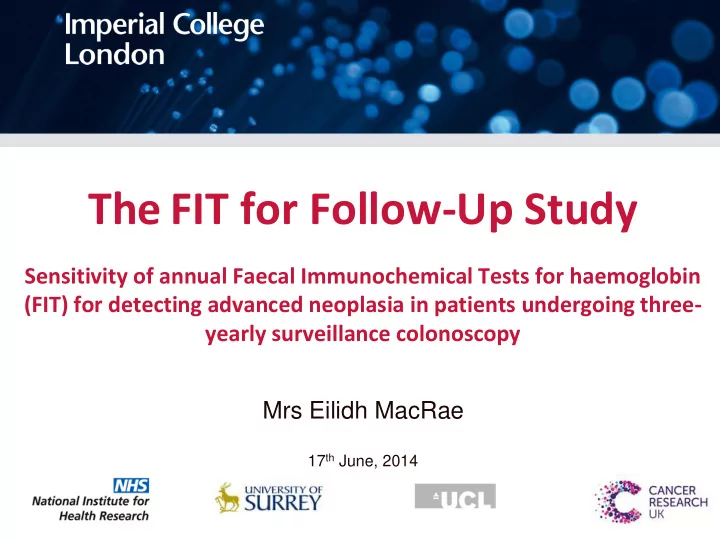

The FIT for Follow-Up Study Sensitivity of annual Faecal Immunochemical Tests for haemoglobin (FIT) for detecting advanced neoplasia in patients undergoing three- yearly surveillance colonoscopy Mrs Eilidh MacRae 17 th June, 2014
Introduction Increasing demand for colonoscopy in the NHS BCSP. Need for effective non-colonoscopic approaches to surveillance. Primary aim of FIT for Follow-Up Study To compare the sensitivity and specificity of annual FIT in detecting advanced adenomas (AA) and/or colorectal cancer (CRC) with colonoscopy surveillance. Secondary aims Acceptability of FIT compared with colonoscopy. Potential of FIT screening to replace colonoscopic surveillance for groups at intermediate-risk of developing CRC. Costs and cost-effectiveness of an annual FIT as an alternative to three-yearly colonoscopic surveillance.
Study Outline Eligibility Aged 60-71 years. Recently diagnosed with intermediate-risk adenomas in the BCSP. Awaiting first surveillance colonoscopy in three years time. Protocol Participants invited to complete a FIT kit annually in the three year interval between screening and surveillance colonoscopy. If the FIT kit is positive (>40 μg Hb/g faeces), the participants are invited to have their colonoscopy brought forward to investigate this result further. Findings at surveillance colonoscopy will be used as the gold standard against which we will measure the programme sensitivity and specificity of the FIT kit.
Progress: Recruitment – Round 1 n = 9851 eligible participants in BCSP database n = 8009 invited/kits sent n = 2123 kits not returned (26.5%) n = 265 excluded/ n = 343 FIT +ve declined/withdrawn n = 5886 kits (5.8%) n = 303 n = 1858 no response returned colonoscopies (73.5%) conducted n = 5543 available to invite in Round 2
Progress: Recruitment – Round 2 n = 5543 available to invite in Round 2 n = 3994 invited/kits sent (72.1%) n = 246 kits not returned (6.2%) n = 44 excluded/ n = 181 FIT +ve declined/ n = 3748 kits (4.8%) withdrawn returned n = 135 n = 202 no (93.8%) colonoscopies response to date conducted to Stable total: 3696/3839 = 96.3% date n = 3769 available to invite in Round 3
Progress: Recruitment – Round 3 n = 3769 available to invite in Round 3 n = 903 invited/kits sent n = 108 kits n = 31 FIT +ve not returned (3.9%) (12%) n = 795 kits returned (88%) Stable total: 638/662 = 96.4%
Round 1 FIT +ve Round 1 FIT positivity rate: - 343/5886 = 5.8% Invited to attend early colonoscopy: n % Attended 303 88.3 Awaiting reports from SC 5 1.5 Did not attend 1 0.3 Declined 28 8.2 Unable to contact 5 1.5 Symptomatic pathway 1 0.3 Total 343 100
Round 1 Colonoscopy Findings Colonoscopy results 303 participants had an early colonoscopy: - 72 (23.8%) F, 231 (76.2%) M Colonoscopy findings: n % Normal 90 29.7 Polyps found 207 68.3 Cancer 6 2.0 Total 303 100
Round 1 Advanced Adenomas Advanced adenomas 73/303 (24.1%) participants classed as having AA 64/73 (87.7%) had one AA n % >10mm 26 40.6 TVA/VA 12 18.8 >10mm + TVA/VA 25 39.1 >10mm + TVA/VA + HGD 1 1.6 Total 64 100 7/73 (9.6%) had two AA 2/73 (2.7%) had three AA
Round 2 FIT +ve Round 2 FIT positivity rate: - 181/3748 = 4.8% Invited to attend early colonoscopy: n % Attended 129 71.3 Awaiting appt date from SC 16 8.8 Awaiting reports from SC 21 11.6 Did not attend 1 0.6 Declined 13 7.2 Unable to contact 1 0.6 Total 181 100
Round 2 Colonoscopy Findings Colonoscopy results 129 had an early colonoscopy: - 39 (30.2%) F, 90 (69.8%) M Colonoscopy findings: n % Normal 40 31.0 Polyps found 87 67.4 Cancer 2 1.6 Total 129 100
Round 2 Advanced Adenomas Advanced adenomas 25/129 (19.4%) participants classed as having AA 21/25 (84.0%) had one AA n % >10mm 2 9.5 TVA/VA 4 19.0 >10mm + TVA/VA 10 47.6 >10mm + HGD 1 4.8 >10mm + TVA/VA + HGD 4 19.0 Total 21 100 3/25 (12.0%) had two AA 1/25 (4.0%) had three AA
Round 1 + 2 Colorectal Cancers Cancer Six participants Round 1 Two participants Round 2 Site Type R1 APP/CM Carcinoid ex-goblet cell type (type B) (pT3 N1 Mx) R1 CM Adenocarcinoma (pT4 N0 Mx) R1 SC Adenocarcinoma (pT4 N2 M1) R1 SC Adenocarcinoma in TVA R1 RS Adenocarcinoma R1 RM Adenocarcinoma R2 TC Adenocarcinoma R2 DC Adenocarcinoma
Participant Satisfaction Participants agree/strongly agree would complete a FIT kit again in the future: 4483/4736 (94.7%) Round 1 FIT-ve 251/276 (91%) Round 1 FIT+ve 2544/2648 (96.1%) Round 2 FIT-ve Participants agree/strongly agree they found it easier to complete a FIT kit for the second time: 2470/2648 (93.3%) Round 2 FIT-ve 91/102 (89.2%) Round 2 FIT+ve
Conclusion Of those testing FIT+ve, 79/303 (26.1%) in Round 1 and 27/129 (20.9%) in Round 2 were diagnosed with AA or CRC. Participant compliance and satisfaction very high. FIT testing and findings at three-year surveillance colonoscopy - gold standard against which we will measure the programme sensitivity and specificity of the FIT kit.
Recommend
More recommend